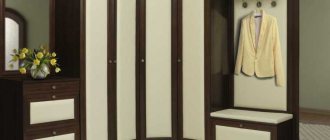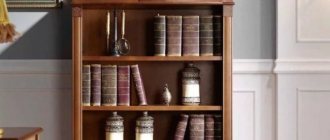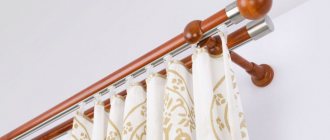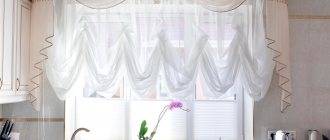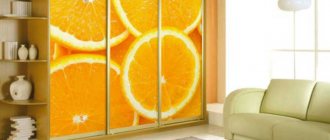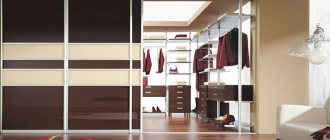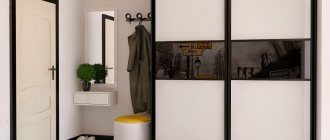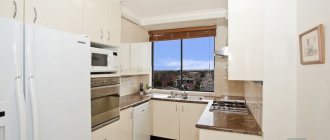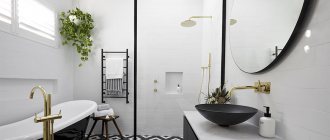18361
A wardrobe is an element of furniture without which it is impossible to imagine a living space. When choosing such an item, you need to consider its functionality. To place the largest number of things in the wardrobe and free up space in the room, you need to purchase a wardrobe with shelves of different types.
Features of the built-in wardrobe
A built-in closet is usually installed in the place of the previous pantry or takes up space along the entire wall up to the ceiling.
Its design is quite simple. And often it does without the back and side walls. This is good because you are, in fact, only buying a facade. And the internal content depends only on your preferences, habits and dimensions of the stored items.
The compartment system includes an upper and lower profile as guides along which the cabinet doors slide. Due to the fact that they move left and right in the same plane, there is plenty of space for incoming guests to calmly take off their outerwear and change their shoes.
In private houses, where the owners can create a spacious hallway at their request, sometimes it is necessary to install the side walls of the closet in order to fit it into the existing room. In this case, it is usually built into a single complex with a chest of drawers, a bench and open hangers for accessories.
The advantage of built-in furniture is that you really use every centimeter of interior space. Spiders do not settle or breed behind the back wall. There are no ugly narrow crevices, which are so difficult to maintain cleanliness and order. You control the condition of the walls. If they suddenly start to get damp, you can dry them in time by simply opening the cabinet and letting in a stream of warm air.
You can purchase powerful retractable storage systems. Because they will not be attached to a 2 mm fiberboard sheet, but to a strong and durable wall.
The advantages of our custom-made wardrobes!
Metering
Done at a time convenient for you: day/evening/weekend. When measuring the premises, we will charge 1000₽, this amount is included in the price when ordering the product. We will show you all the samples and choose them to suit your interior and lighting. We will advise you on the contents, draw a sketch to understand the functionality, and obtain a practical cabinet. During the measurement, we will announce the cost of each part, so you can understand what the price of a custom-made wardrobe consists of.
Prepayment/Payment
Prepayment is required for orders over RUB 50,000. When ordering from 50,000₽, we take an advance payment of 30% of the cost of the product, the remaining 70% after INSTALLATION!
Agreement
We sign after approval of all components, agreement on price, date and time of installation. You have 3 days to make changes after signing the contract.
Installation/Warranties
Installation cost 15% of the cost of the cabinet. The installer receives his 15% after you positively evaluate his work. The installer is also personally responsible for the quality of the product. Our specialist personally gives a 36-month guarantee, this is confirmed in writing in the contract. If within 36 months the cabinet raises any complaints, the installer comes and fixes them.
Production time
5-10 days depending on the complexity of the order, the selected accessories and production workload.
Design
12 facades: classic, painting parts according to the RAL color catalog, sandblasting glass/mirror, photo printing on doors, glossy AGT/Alvic panels, Lakobel/Oracal colored glass, 140 colors of Egger chipboard, and an endless number of combinations.
Safety
We use safe and high-quality Egger laminated chipboard of emission class E 1. All materials and fittings are certified. Reliable fittings for sliding doors do not allow them to jump out of the guides and last for 110,000 cycles (30 years). All glass is covered with a safety film and does not crumble when broken.
Employees
All specialists of our company are Russian and are residents of Moscow and the region. Our installers of built-in furniture have over 12 years of experience. 5-8 specialists work on each project.
Varieties
It would seem that it would be simpler: install the façade from wall to wall and that’s it, the cabinet is ready. But it was not there. Designers have developed many options even for such a simple design.
- Sliding wardrobe with one side . Occurs in situations where the storage system is located in the corner of the room. In this case, the wall is longer than the cabinet. And the owners want to leave a small niche for a bench on which you can sit to change your shoes.
- Built into a single complex . This option has already been discussed above.
- With mezzanines . You don’t always want to show guests things stored on the top shelf. In this case, the cabinet has an upper shelf-ceiling, for which separate facades are made. In some projects you can find an original solution when mezzanines are hung above the entrance doors. In such interiors, every centimeter of the hallway is used to the maximum.
- The entire wall . The classic option is when the closet takes up all the space along the blank wall of the hallway.
- With niches . Between the doors there may be a niche in which you can put a bench or chest of drawers. Hanger for hats and bags, key holder, etc.
- Around the corner . If the width of the corridors allows, the cabinet can go around the wall and smoothly flow into the hall.
- Angular and radius . Suitable for spacious rooms, because the diagonal facade eats up a lot of space. The filling is located along two walls. Therefore, the only way to justify enclosing an unused area is the desire to fill an obvious void. The use of shelves adjacent to the facade is difficult due to their triangular shape. In radial projects, this inconvenience manifests itself to a lesser extent. With the concave shape of the facades, more space remains in the hallway.
- Trapezoidal . They have two side walls. They are a type of corner. The straight line of the facade simplifies the process of replacing them. Instead of contacting a specialized workshop, it is enough to buy suitable doors at any furniture store.
Types of office cabinets
- A regular wardrobe is a traditional model, usually equipped with hinged doors. If necessary, it can be moved or moved. Such a cabinet is a little more difficult to fit harmoniously into the interior and space of the room than a sliding wardrobe. You have to somehow adapt to the characteristics of the room, and because of the protruding baseboards, such cabinets, as a rule, cannot be placed close to the wall.
- Sliding wardrobe – this type of wardrobe has sliding doors. It is built into a wall niche. As a rule, it is produced to order, which allows taking into account all the needs of a specific user, the features of the layout and design of the room. If you move, such a cabinet usually remains and is not moved, since it is rigidly tied to the area and is difficult to disassemble/assemble. See what a modern wardrobe looks like in an office in the photo.
- A pencil case is a tall, narrow cabinet, perhaps with or without a door. Compact and quite roomy (due to its height). The optimal solution for a compact office.
- A secretary is a combination of a cabinet and a desk. Equipped with drawers and a shelf, as well as a retractable or folding board that serves as a table. Such models are also very suitable for offices (accounting, filing cabinets).
- Clothes - a model with one or two doors, equipped with a crossbar (bar) and hangers. Such a closet often has an upper shelf for placing hats and other items (umbrellas, gloves). There are models with mirrors, baskets, drawers and tie holders.
Wardrobes are designed to store outerwear for office employees and visitors. Often used to store a change of clothes, for example, suits for important events and personal belongings (cosmetics, toilet water).
Preference should be given to deeper models so that hangers (for the crossbar) can be placed inside freely. You can ignore this if special mechanisms are provided inside, with the help of which hangers can be positioned sideways and not frontally.
For documents, the shelves in such models, as a rule, correspond in size to A4 format. Often, cabinets of this type are equipped with locks that prevent unauthorized persons from accessing important documents. Below are examples of document cabinets (office) in the photo.
There are two main types of filing cabinets depending on the design:
- For managers there are solid glazed cabinets reminiscent of book models. They are often used as a kind of showcase representing the company.
- For employees - practical models with a more modest design, equipped with blind doors.
Our company produces various types of office cabinets to order. Products are produced according to an individual design project, which provides for all the features of the premises and the corporate style of the company. A custom cabinet is guaranteed to fit your office perfectly as it is made specifically for it.
Dimensions
The size of the cabinet depends on your preferences. The width of sliding doors is from 40 to 80 cm. The average size is 60 cm.
The width of the storage system depends on the number of doors. The minimum quantity is two, and more than 5 are divided into separate sections, interspersing them with niches.
The height is limited only by the ceiling. Of course, the closet does not have to be the entire wall. It may be lower. It all depends on the interior design and the effect that the designer wants to achieve.
Materials
- Straight forms are easily made from laminated chipboard, MDF, plastic and any other sheet material. (Here read “What is chipboard in furniture, decoding”)
- For facades, colored glass is often used, which can be translucent or frosted.
- Mirrored doors create the illusion of a deep perspective and visually double the room. Thanks to them, the light output of the walls increases, and the light bulbs shine brighter.
- Curvilinear forms are made of MDF or tempered glass.
Decoration methods
- For MDF and chipboard, laminated film is used. It is capable of creating high-quality imitation of natural materials: leather, wood, stone, etc.
- Glass doors are sandblasted. The combination of matte and glossy surfaces creates a unique design.
- Triplex makes it possible to use photo printing and place a film with an image between two glasses. This reliably protects the picture and protects it from damage.
- Photo printing can also be applied directly to sheet material. In this case, a special wide-format printer is used.
- Printing on self-adhesive film . A common technique that allows you to inexpensively and beautifully decorate your closet. However, in this case, you need to handle the facade with extreme care so that accidental scratches do not destroy the beauty.
In addition, designers also use simple techniques.
- Dividing the plane with vertical and horizontal stripes.
- A combination of materials with different textures and colors.
What's inside?
First of all, you should ask yourself a simple question: what will be stored in this closet?
- What kind of outerwear? Its length. If you do not wear long coats and raincoats, then it is better to set aside part of the closet under jackets for something else.
- How many shoes are in your wardrobe? Put it together and meticulously evaluate the actual volume. To optimize storage, use compact wire systems. They are designed to accommodate a large number of pairs while taking up as little closet space as possible.
- Hats and caps. Knitwear does not like hangers. It is better to have a separate shelf for it. Felt can put up with hooks. Still, the best place for hats is on a shelf.
- Gloves and belts. They are conveniently stored in narrow drawers or on shelves in organizer cells.
- Umbrellas. This is a separate story, because the popular cane umbrellas are difficult to place on a standard shelf. It is better to make a separate holder for them in the form of a basket. Even an ordinary PVC pipe, the size of a third of the length of an umbrella, can significantly alleviate this issue. For folding models, a drawer or low shelf is sufficient.
- Cosmetics . It’s convenient to fix your hair and makeup when leaving the house if you have everything you need at hand. To do this, one or two shelves are enough, or better yet, drawers with convenient organizers. So that each item floats easily into your hands.
- Vacuum cleaner . I want to put these long hoses and handles compactly so that they don’t get in the way. To do this, screw holders for the drawbar, hoses and nozzles onto the wall. All. Now your closet will be in perfect order.
Of course, the closet can store many other items from multicookers to balls and fishing rods. Just make a list and assign a place for each item.
Types of shelves
A typical cabinet is a structure that consists of a body, doors with fasteners, and storage shelves. Depending on the model, the kit may additionally include a rod, a drawer, and a device for ties. There are a huge number of combinations and modules with which you can greatly facilitate the search for the right thing and put things in order in your closet.
Properly planned and organized filling of the closet requires additional costs, but helps save time.
A closed furniture cabinet can be divided into 3 main parts:
- mezzanines for storing rarely used items, boxes, bags, small items;
- main compartment, which is most convenient for storing frequently used items;
- lower part, for small items, shoes, accessories.
Shelves for a cabinet can be made from the main material of the product or differ from the body, creating additional contrast if the cabinet is open. The material of the load-bearing elements and fastenings affects the strength and functionality of the internal filling.
There are two main types of shelves:
- stationary;
- removable.
Stationary
Removable
The first type of parts is designed for storing things. They serve as a load-bearing element, which helps to avoid distortions in the structure and balance the load. They are made from the same material as the frame parts. The second type of shelves implies the possibility of reinstallation. It is recommended to make such removable elements from wood, glass, and metal. Pressed furniture fabrics can crumble during repeated assembly, losing their attractiveness and functionality.
Depending on the material, the shelves can be made of:
- wood - natural and durable, used in book racks and spacious walk-in closets;
- set array;
- wood panel (light, durable);
- glass (light, durable, easy to clean);
- metal sheets;
- Chipboard, MDF (the cheapest option, toxic).
Chipboard, in addition to the wood base, contains formaldehyde resin, which can release harmful substances. Shelves are considered safe if the ends are sealed with an edge (plastic, film, veneer).
Wooden
Metal
Glass
Retractable systems
For outerwear, stationary rods are usually used. They are good for down jackets, fur coats and coats.
In narrow niches it is better to install retractable holders. They are attached to the shelf located above and slide out along a guide. This way you provide compact storage for jackets, jackets, and raincoats.
Shoes can be stored in specially equipped drawers-shelves, carousel-type columns, simply on shelves and in folding compartments.
If the boxes are transparent, then it’s easy to see what’s where. Men like it because at first glance it is clear where to look for the right thing.
The pantograph helps optimize space and store clothes on high rods. It is enough to take the pantograph handle and the desired objects fall directly into your hands. Outerwear has a significant weight. Therefore, the device is equipped with gas lift type closers.
As you can see, buying a good cabinet is quite difficult. It is much easier to do it taking into account your lifestyle, habits, number of things stored and individual preferences. In this case, the hallway will be as comfortable as a glove on your hand.
Having installed a built-in wardrobe in the hallway, all that remains is to think through the rest of the corridor design. For this purpose, we have prepared a special article in which we talked about modern innovations in hallway design -
Types of open wardrobes
In small apartments, cabinets behind curtains do not require the installation of doors; you only need to install hangers, shelves, cabinets and modules, which can be swapped if desired. There are a huge number of similar cabinets, so choosing a suitable option for your dressing room will not be difficult. It is important to take into account the layout features, the size of the room or hallway, and the style of the premises.
For residential premises, dressing rooms behind the curtain have different designs and shapes:
- Modular - based on the use of metal parts. Suitable for storing clothes, tools, accessories, household items.
This type of cabinet includes hangers, laundry baskets, shoe racks, racks, and special fastenings for trousers and outerwear. - Open - suitable for creating a sense of style, lightness, economical and smart use of space in a room. There is no back wall in such systems, but there are partitions, making the cabinet spacious and functional.
The system is closed with a curtain or curtain and mounted on aluminum posts. Shelves, chests of drawers, and hangers are placed between them. - Cellular is very compact, versatile, and includes a huge number of baskets, shelves, and shelves.
The peculiarity of all elements is that they are mesh. - Wall-mounted - consists of fastenings, rods for clothes, racks, various elements for placing things on the floor and hangers. For such a dressing room, you can use a curtain to cover clothes and shoes.
Such options in the form of separate elements - hangers and shelves for shoes - can be placed in a small hallway.
